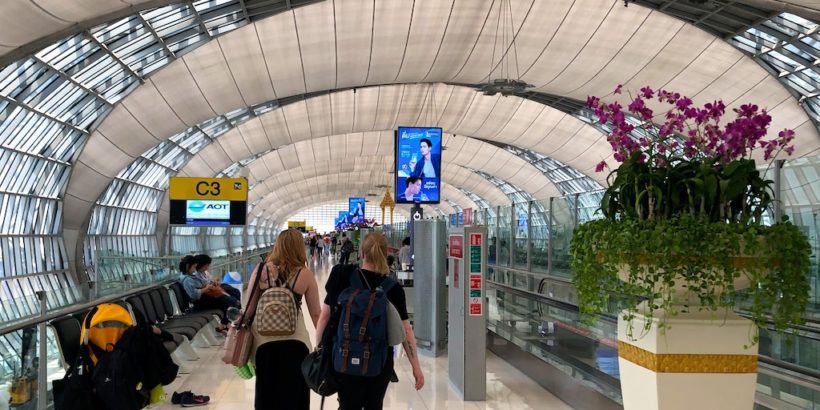If you don’t have a lot of experience dealing with connecting flights, having a short layover can be a bit nerve-racking. Many travelers wonder whether or not 50 minutes to one hour will be enough time to make it to their connecting flight.
I’ve flown on many connecting flights including those with a one hour layover and so I’ll tell you everything that you need to know based on all my first-hand experiences. I’ll also provide you with some tips when dealing with short layovers.
Table of Contents
Is a 1 hour layover enough time for a connecting flight?
Yes, one hour is enough time for a layover when making a connecting flight in many airports. However, if you are flying from a destination known to have delays or flying international you may want to choose a flight that allows for more time.
Let’s take a look at some of the major factors you should consider.
Tip: Use the free app WalletFlo to help you travel the world for free by finding the best travel credit cards and promotions!
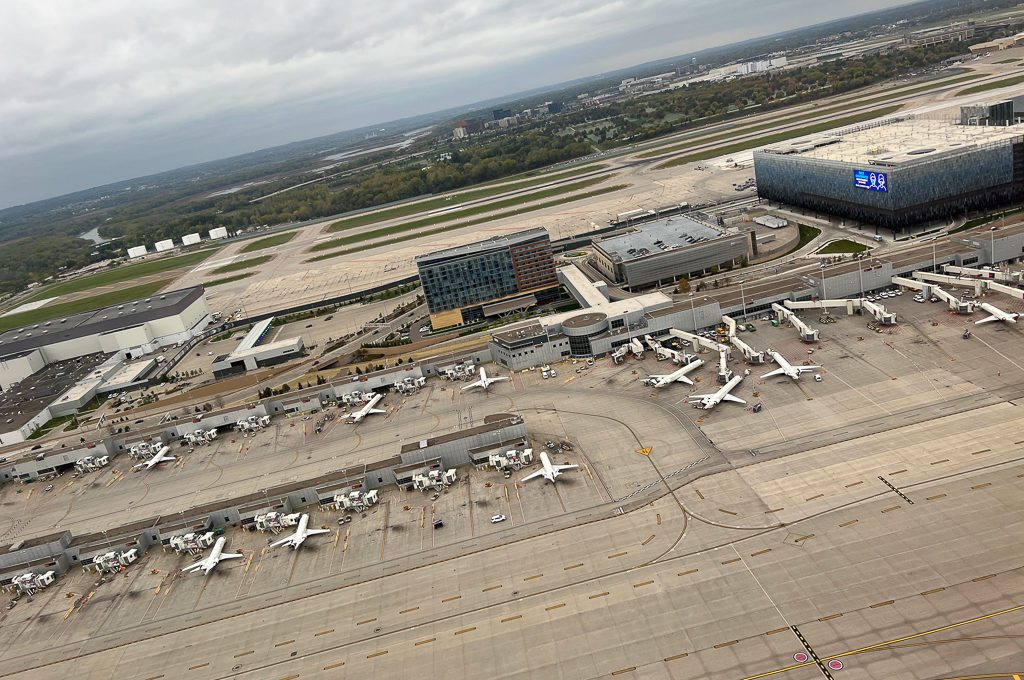
Same itinerary or different itinerary?
Your biggest concern when dealing with a one hour layover is whether or not your reservation is on the same itinerary or different itineraries.
Being on the same itinerary means that whenever you view your booking, you see all of your connecting flights listed together (even if they are on different airlines or codeshares).
Different itineraries means that you made separate bookings for your flights and you essentially designed the connection.
If something happens and you miss your connection when your flights are on the same itinerary, the airline that caused the delay should work with you to either offer you a refund or find you another flight.
On the other hand, if you miss your connection because your flight on a separate itinerary was late, you may not have any recourse at all.
That’s why I strongly recommend against going with a one hour connection if your flights are on different itineraries. You could end up out of luck and out of money.
Another thing to consider is that if you book a connection with the same airline there’s a good chance that your connecting flight will be in the same terminal.
For example, on a recent connecting flight with Alaska Airlines our connecting flight was only a couple of gates over which meant that it only took a few minutes to get to the boarding area for the next flight.
But if you book separate itineraries with different airlines your connecting flight might be at a completely different terminal.
That might mean that you need to walk an extended distance or even ride a tram to get to your connecting flight. In some cases, you might even have to go through security once again.
Related: Are Airlines Responsible for Missing Connecting Flights?
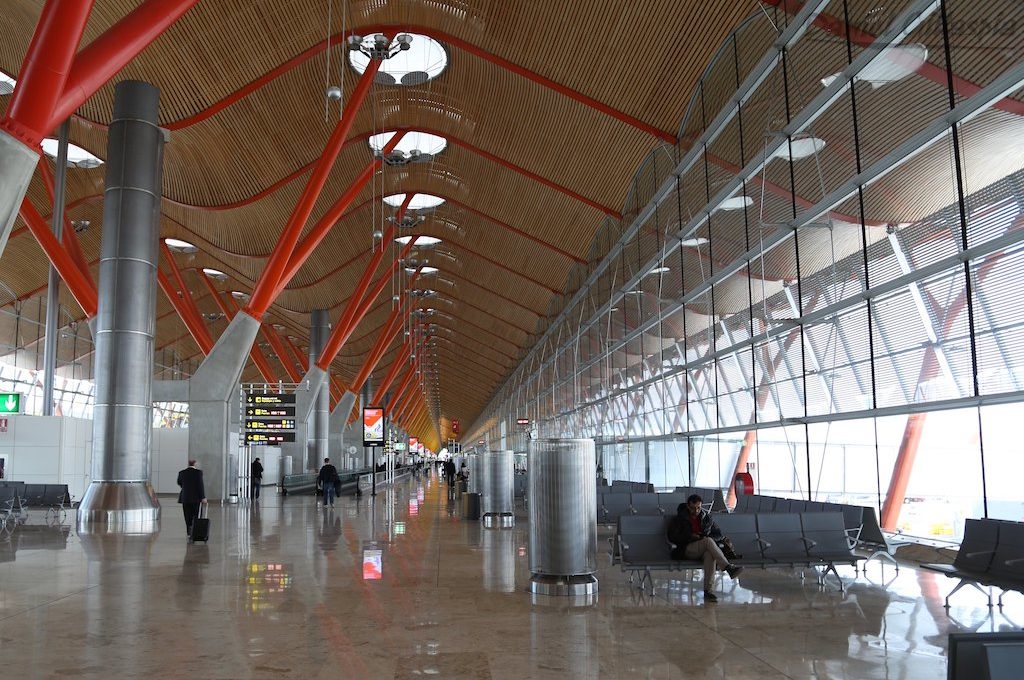
Minimum connection times (MCT)
A minimum connection time (MCT) is the minimum amount of time you have in order to make a successful connection at an airport.
You can generally find how much time you need for a connection by searching for minimum connection times (MCT) for specific airports on forums like Flyertalk.
A lot of factors can determine the MCT such as the layout and specific procedures of an airport as well as the day of the week, etc.
Therefore, it’s not always so black-and-white as to whether or not your connection time would be under the minimum connection time. This is why you want to book your connecting flight on the same itinerary.
An airline is not (or at least should not if things are working properly) sell you itineraries that force you to make a connection under the minimum connection time.
Tips for dealing with a one hour connection time
Below are a number of tips that should help you deal with a one hour connection time.
Get help from the airline if you can
One thing to note is that some alliances have agreements in place to facilitate connections when the connection is going to be tight.
For example, the Star Alliance has a team/service to help you make your connections at airports including:
- Frankfurt (FRA)
- Munich (MUC)
- London Heathrow (LHR)
- Chicago (ORD)
- Denver (DEN)
- Houston (IAH)
- New York- Newark (EWR)
- Los Angeles (LAX)
- San Francisco (SFO)
- Toronto (YYZ)
Furthermore, if your original flight is delayed and you’re flying the same airline/itinerary, the airline will probably hold the door open a little bit longer if it is practical for you to still make it to the gate in time.
This is especially true if there are multiple passengers connecting from that delayed flight. I recall a Southwest flight where they waited several minutes for a dozen or so passengers to arrive.
So it might give you a little bit of peace of mind to know that airlines are willing to help you out in these cases.
Purchase first class or upgrade to economy plus
If you purchase a first class ticket you will likely be among the first to board and also the first to get off the plane.
Being able to exit the plane first can save you several minutes which can be very valuable whenever you are cutting things close.
If you’re not able to purchase a first class ticket then consider upgrading to something like an economy plus ticket.
With a ticket like that, you can get extra legroom and even other perks sometimes like free alcohol. But in this situation with a one hour layover the big perk is being able to exit the plane quickly.
Related: Is Business Class Worth It? (What to Look for)
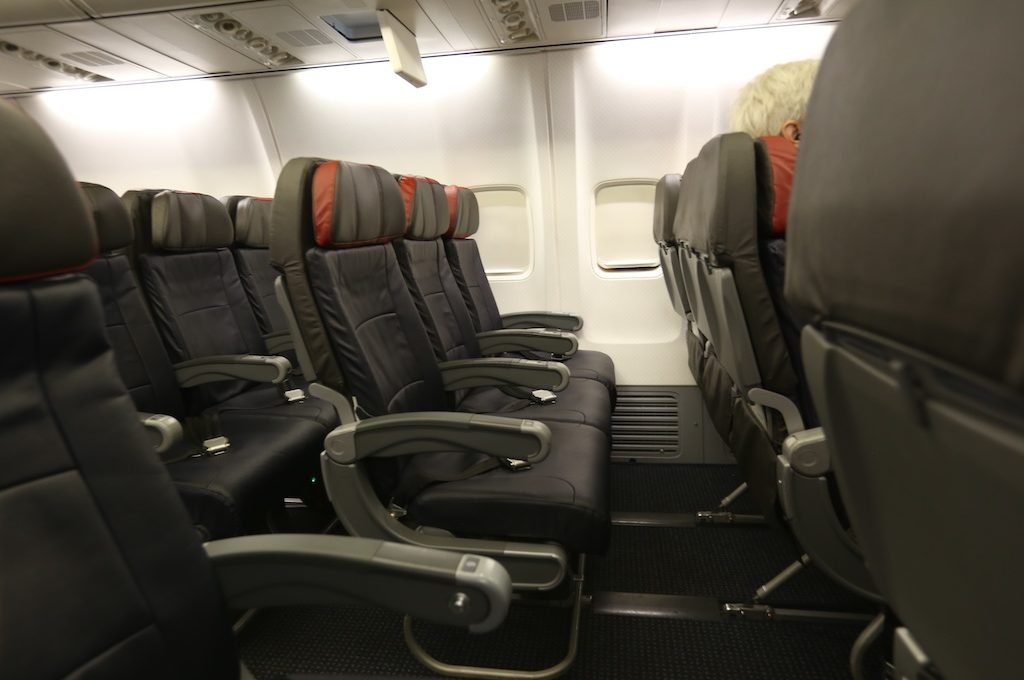
Get familiar with the airport map before you depart
Whenever you print your boarding pass and you have connections you may be able to see the exact gate that you will be landing at and also the gate where your connecting flight will be departing from.
Some airlines even send you a special email to help you navigate the connection so be sure to check your inbox whenever you land. (You can also often see this in the airline’s app.)
If you know where your connecting flight will be departing from then you can do a quick Google search and pull up the map of the airport to get a sense of where you need to go.
If you are unsure about how long it will take you to get where you need to go, just ask someone that works for the airline how long it will take you to get to your desired gate as soon as you enter the airport and they should be able to help.
Don’t book one of the last flights of the day
If you’re going to be potentially cutting things close with a one hour layover, you don’t want to book the last flight of the night. That’s because if your flight happens to be delayed your only option might be to wait until the next morning to fly out.
This could cause you to have to book a hotel or if you can’t do that having to essentially spend the night at the airport.
Related: 19 Ideas on What To Do When Bored at the Airport
Pre-purchase snacks for your second flight
When dealing with a short layover, you may not have time to wait in line or to wait for your food to be prepared when ordering from one of the restaurants inside the airport.
For that reason, it is a good idea to bring some snacks with you so that you will not be starving on the plane or pressured to cut things way too close.
If you are flying first class, you’ll probably receive a meal or some snacks so those can hold you over.
Go to the bathroom towards the end of your flight
Just like hunger, having to go to the bathroom when rushing to make a connection can make matters much worse.
It can also slow you down and if you are dealing with any kind of delay on a one hour layover, every minute counts.
So my advice is to go to the bathroom right before or whenever it’s announced that you need to put your seat back in its normal position and get ready for landing.
Optimize your luggage situation
Flights will generally start to board about 30 to 40 minutes prior to departure. This means that when you only have 60 minutes on a layover you may not arrive when boarding starts.
That could mean you boarding with one of the last boarding groups and missing out on valuable overhead storage bin space.
To avoid having to check your carry-on bag and dealing with all of the stress that comes with it, consider minimizing your carry-ons.
Speaking of your luggage, you also always want to verify that your luggage would not have to be picked up at your connecting airport.
For your typical domestic flight, your luggage will arrive at your final destination so you won’t have to worry about picking it up on your layover.
If you’re flying with different airlines you can inquire about interline baggage agreements.
This is when airlines (including non-partners) will allow your baggage to go through to your final destination sometimes even on connecting flights that are not part of the same itinerary.
I’ve done this a few times in the past but one of the times I did it my luggage was lost so I try to avoid it.
Still, this could be a lifesaver in some situations especially when you only have one hour to make your connecting flight.
Consider the weather
Certain destinations are known for weather delays.
For example, if you were flying in January through the Northeast, there is a chance you might be dealing with a snowstorm.
If you’re flying out of Southeast Alaska during the summer or rainy season, there may be fog or low lying clouds that delays your flight.
Try to avoid booking tight connections when there is a decent chance of a weather delay.
Give yourself more time for international flights
Under ideal conditions, you could make a one hour connection work on an international flight, especially if you have something like Global Entry, no checked baggage, etc.
However, in a lot of cases you may not be able to make your international flight.
That is because in a lot of cases such as whenever you land back in the US, you will have to go through customs and immigration and then also go back through security once again.
If the airport is a madhouse then getting through all of those and collecting your bag and re-checking it could easily take over one hour and you could miss your connection.
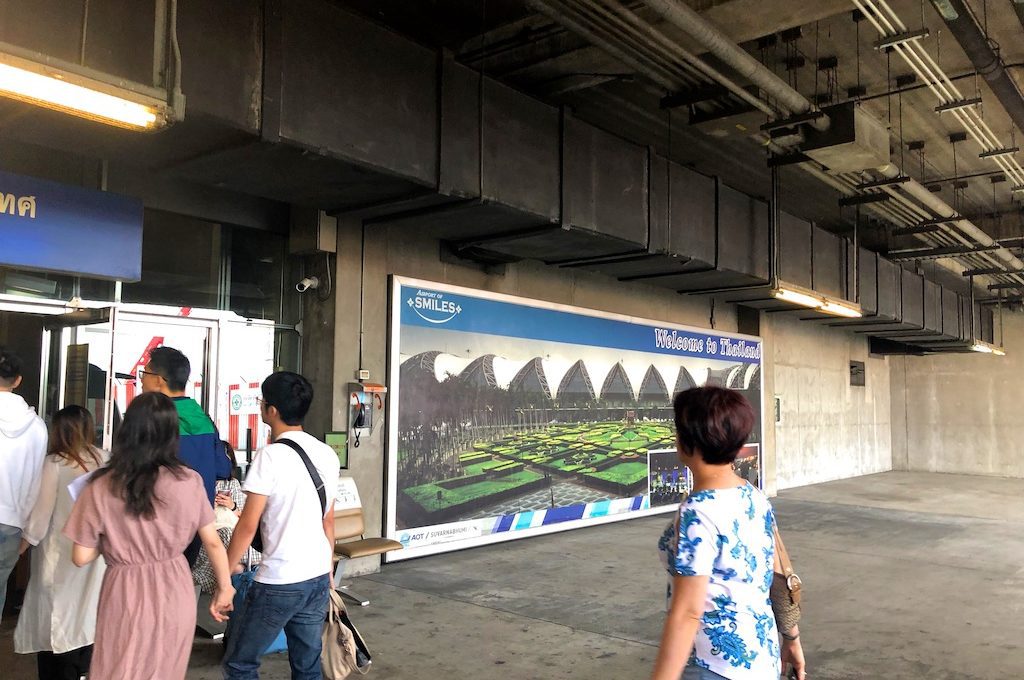
Get TSA Pre-Check
TSA Pre-Check can help dramatically with getting you through the airport efficiently.
There are quite a few benefits to the program that allow for more convenient travel through airports.
First, you often only have to pass through a traditional metal detector (as opposed to the invasive full-body scanners) and you also get to enjoy the following benefits:
- Shoes can stay on
- Belt can stay on
- Light jackets can stay on
- Laptops allowed to stay in bag
- Liquids (3-1-1 Rule) can stay in bag
If you ever find yourself having to go through security in order to board your connecting flight this could shave off a good 10 minutes or more in some cases. Again, every minute counts sometimes.
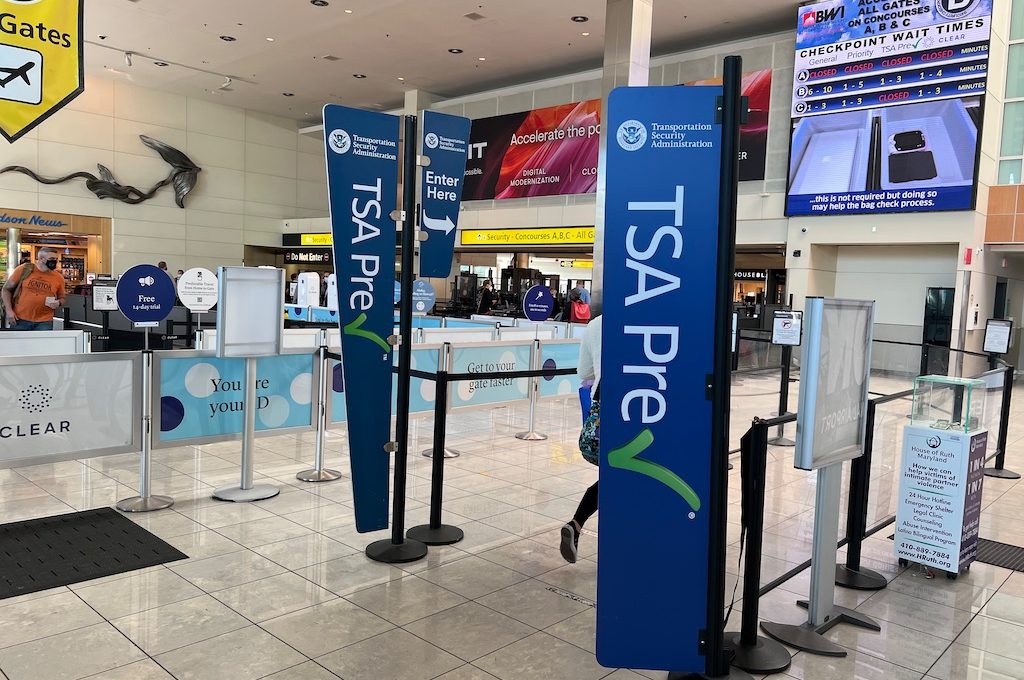
What to do if you miss your connecting flight
If you happen to miss your connection on a one hour layover, don’t panic.
If you have all of your flights on a single itinerary you just need to approach a desk for that airline and let them know about your situation.
They should be able to start working on a solution for you immediately.
If you want to help speed things up you can actually start to search for other flights that could work and that might expedite the situation since you can offer proposed flights to change to.
If your flights are on different itineraries there is a very high chance that the airline will tell you that they cannot do anything for you.
If you are arriving within two hours of your departure you can request that they use the “flat tire rule” which is sort of an unofficial rule that allows passengers to get placed on flights or standby whenever they miss their flights.
This will probably be your only solution other than purchasing a walk up fare which could potentially be much more expensive.
Final word
A one hour layover should allow you to make your connection on a domestic flight without any issues in the majority of cases.
If there is a substantial delay to your original flight then you might run into some trouble but even then a lot of times you can still make your connection.
If you are flying on an international flight and having to go through baggage claim, customs, immigration, and security, then a one hour layover is almost certainly a bad idea.
Daniel Gillaspia is the Founder of UponArriving.com and the credit card app, WalletFlo. He is a former attorney turned travel expert covering destinations along with TSA, airline, and hotel policies. Since 2014, his content has been featured in publications such as National Geographic, Smithsonian Magazine, and CNBC. Read my bio.

